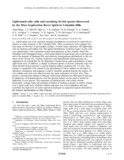| dc.contributor.author | Wang, Alian | |
| dc.contributor.author | Bell, J. F. III | |
| dc.contributor.author | Li, Ron | |
| dc.contributor.author | Johnson, J. R. | |
| dc.contributor.author | Farrand, W. H. | |
| dc.contributor.author | Cloutis, E. A. | |
| dc.contributor.author | Arvidson, R. E. | |
| dc.contributor.author | Crumpler, L. | |
| dc.contributor.author | Squyres, S. W. | |
| dc.contributor.author | McLennan, S. M. | |
| dc.contributor.author | Herkenhoff, K. E. | |
| dc.contributor.author | Ruff, S. W. | |
| dc.contributor.author | Knudson, A. T. | |
| dc.contributor.author | Chen, Wei | |
| dc.contributor.author | Greenberger, R. | |
| dc.date.accessioned | 2018-03-07T14:50:56Z | |
| dc.date.available | 2018-03-07T14:50:56Z | |
| dc.date.issued | 2008-12-19 | |
| dc.identifier.citation | Wang, A., J.F. Bell III, R. Li, J.R. Johnson, W.H. Farrand, E.A. Cloutis, R.E. Arvidson, L. Crumpler, S.W. Squyres, S.M. McLennan, K.E. Herkenhoff, S.W. Ruff, A.T. Knudson, W. Chen, R. Greenberger, and the Athena Science Team. "Light-toned salty soils and coexisting Si-rich species discovered by the Mars Exploration Rover Spirit in Columbia Hills." Journal of Geophysical Research - Planets, 113 (E12) (2008): E12S40; doi:10.1029/2008JE003126. | en_US |
| dc.identifier.issn | 2169-9097 | |
| dc.identifier.uri | http://hdl.handle.net/10680/1390 | |
| dc.description.abstract | Light-toned soils were exposed, through serendipitous excavations by Spirit Rover wheels, at eight locations in the Columbia Hills. Their occurrences were grouped into four types on the basis of geomorphic settings. At three major exposures, the light-toned soils are hydrous and sulfate-rich. The spatial distributions of distinct types of salty soils vary substantially: with centimeter-scaled heterogeneities at Paso Robles, Dead Sea, Shredded, and Champagne-Penny, a well-mixed nature for light-toned soils occurring near and at the summit of Husband Hill, and relatively homogeneous distributions in the two layers at the Tyrone site. Aeolian, fumarolic, and hydrothermal fluid processes are suggested to be responsible for the deposition, transportation, and accumulation of these light-toned soils. In addition, a change in Pancam spectra of Tyrone yellowish soils was observed after being exposed to current Martian surface conditions for 175 sols. This change is interpreted to be caused by the dehydration of ferric sulfates on the basis of laboratory simulations and suggests a relative humidity gradient beneath the surface. Sirich nodules and soils were observed near the major exposures of S-rich soils. They possess a characteristic feature in Pancam visible near-infrared (Vis-NIR) spectra that may be diagnostic of hydrated species, and this spectral feature can be used to search for additional Si-rich species. The exposures of hydrated salty soils within various geomorphic settings imply the potential existence of hydrous minerals in similar settings over a much wider area. Hydrous sulfates represent one of the candidates that may contribute the high level of water equivalent hydrogen in equatorial regions detected by the Neutron Spectrometer on Mars Odyssey. | |
| dc.description.sponsorship | We thank NASA for funding the MER Athena Science team and the JPL engineering team for continuing to
successfully operate the Mars Exploration rovers. | |
| dc.description.uri | https://agupubs.onlinelibrary.wiley.com/doi/abs/10.1029/2008JE003126 | |
| dc.language.iso | en | en_US |
| dc.publisher | Journal of Geophysical Research | en_US |
| dc.rights | info:eu-repo/semantics/openAccess | |
| dc.title | Light-toned salty soils and coexisting Si-rich species discovered by the Mars Exploration Rover Spirit in Columbia Hills | en_US |
| dc.type | Article | en_US |
| dc.identifier.doi | 10.1029/2008JE003126 | |

